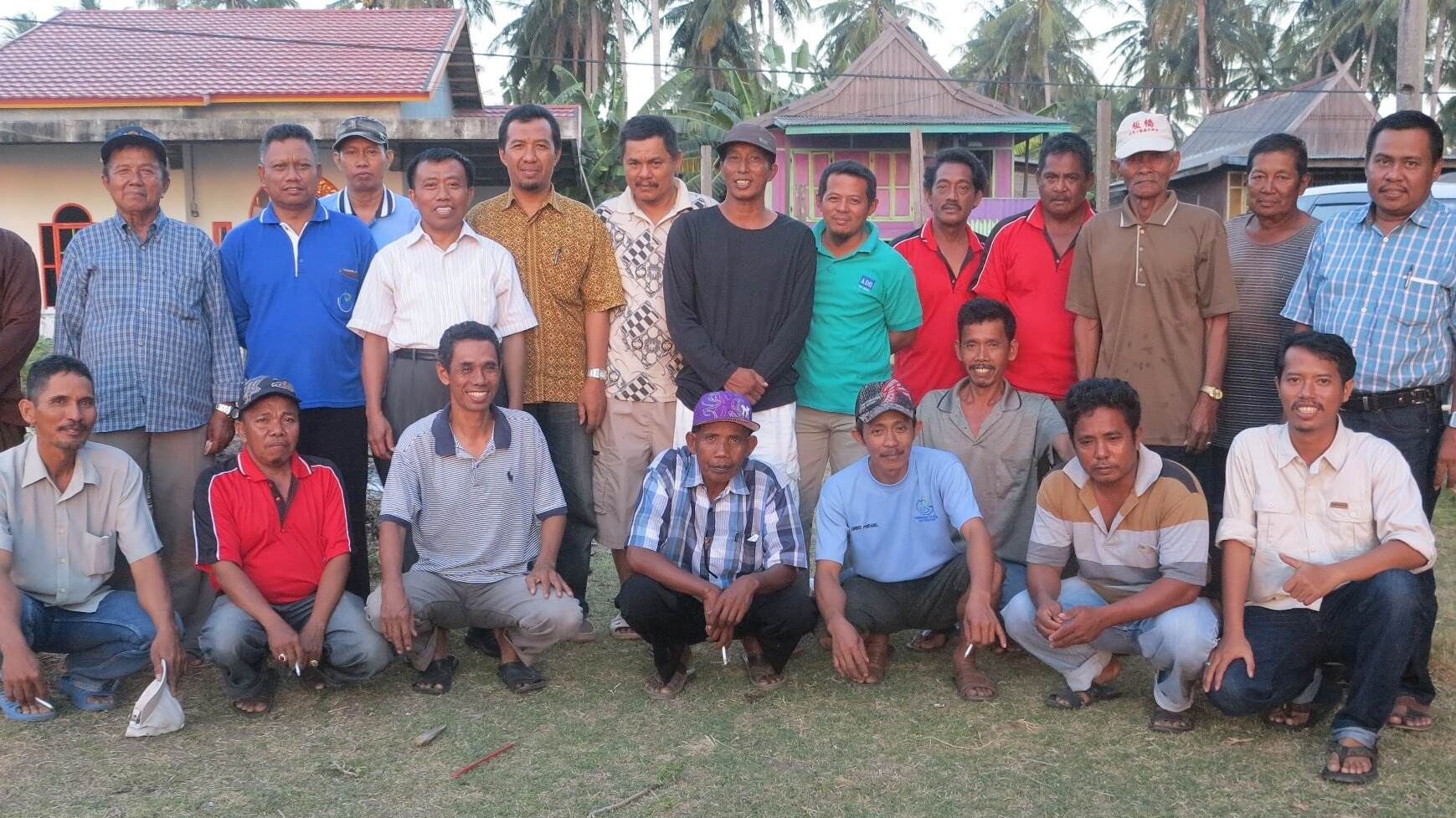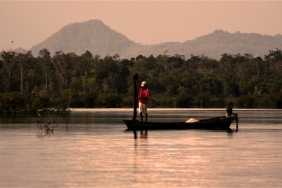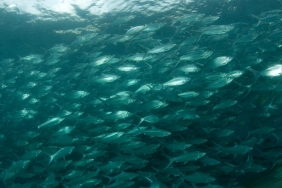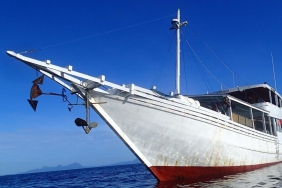YOUTH: DRIVERS OF CONSERVATION ACTION, AGENTS OF SUSTAINABLE POLICY CHANGE
In the future, youth programs are expected to produce a generation with attitudes and skills. Youth can also be the driving force behind nature conservation actions, influencing communities and encouraging policy changes that are more environmentally friendly.
The thick mist in the afternoon welcomed me and the participants of the NatureXYouth Training of Trainers for Biodiversity, Our Food and Nation Pride at Saung Sarongge on Friday (7/02). The village, located at the foot of Mount Gede, Cianjur, West Java, is an area built for tourism and education purposes since 2013. The cool mountain air made my mind calm. The atmosphere of this place is indeed conducive to a training event.
Our learning space for the next four days is a stage-shaped hall built from a dozen different types of wood. According to Mas Tosca Santoso, a writer and activist who fights for the rights of farmers, Saung Sarongge used to be a place for farmers in Sarongge Village to gather and do activities. Now, it is used as a homestay and hall for public activities.
In this place, I, my fellow Panda Mobile volunteer Rafika Rosmalida, and other facilitators representing the Earth Hour (EH) community in Jabodetabek, EH Bandung, EH Cimahi, EH Bandar Lampung, Marine Buddies, Scouts, Islamic boarding schools, and representatives from universities felt motivated to carry out the scheduled activities. We will undergo training from WWF-Indonesia's Education for Sustainable Development (ESD). ESD promotes the idea of education for sustainable development so that the Earth is 'enough for all, forever'. The first material we learned was about biodiversity.
The event started with a unique question. "If given the chance to reincarnate, what would you like to be?" That was the first question asked by WWF-Indonesia ESD Program Coordinator Mrs. Rini Andriani when opening the introduction session. Participants gave various responses. Some said they wanted to be worms, cats, eagles, and coconut trees. From these answers, we have begun to know about the biodiversity that exists on Earth.
After the introductory session and a brief explanation of ESD, the other participants and I were divided into groups to stay at a local house. This was part of the five-day, four-night live-in program at Saung Sarongge.
On the next day, we began to explore material about education, sustainable development, and the role of youth to realize it. We started by understanding the 2016 Living Planet Report (LPR). In that year, WWF had issued a report based on scientific analysis of the health of planet Earth and its impact on human activities. In that document, WWF noted that changes in biodiversity, ecosystems and human consumption of natural resources showed an alarming trend. The ecological footprint of the world's population has exceeded the planet's ability to naturally repair itself (biocapacity) by 50 percent. This means that it takes 15 years for the Earth to produce the resources consumed by humans in one year.
From the WWF report, we realize that the condition of the Earth is alarming. Therefore, citizens of the world must act to protect and preserve our one and only home. In this case, young people play an important role to voice the importance of sustainable development issues to be raised to the public agenda. Youth can also be the axis of action for various nature conservation programs. Youth-led movements are expected to influence their surrounding communities to take similar actions, thus encouraging policy changes that are more environmentally friendly. Therefore, youth programs are directed to produce young people who have the attitude, skills, and concern for the environment.
One of the briefing materials for trainees who are expected to become youth drivers of environmental action is about the principles of education and sustainable development. We learned this lesson from Mrs. Yayah Komariah. She is a principal who was able to transform SDN Bantarjati 9, Bogor City, which looked Hot, Arid, Slum, and Poor (Pager Kumis) into Shady, Shady, Asri, and Beautiful (Rindu Asti) and received an Adiwiyata award. Her innovation in making these changes was quite creative. Ms. Yayah's presentation succeeded in making me hypnotized and observed every effort of change.
Yayah's presentation began with a description of SDN Bantarjati 9 in 2006. The school walls were full of dust and there were palm prints on the surface. The air was dry. Not a single plant could be seen as far as the eye could see, it was barren. Teachers came at noon. No one seemed to "own" the school. "Pager Mustache. Hot, Arid, Slum, and Poor," was the term used by Ibu Yayah to describe the atmosphere of her workplace at that time.
Mrs. Yayah did not remain silent. She strategized to change the condition of SDN Bantarjati 9 for the better. She began to require every student and teacher to bring one tree to be planted at school. Mrs. Yayah called it "Sawa Sapo", short for One Student One Tree, and "Sagu Sapo" which stands for One Teacher One Tree. Not only that, she also popularized other jargons such as "Semutlis" or "Ten Minutes for School", "Libra" which means "See the Mess, Tidy Up!" and "Lisa" which stands for "See the Trash, Take It!"
This process of change took a long time. However, Ibu Yayah never gave up and continued to maintain good habits in the school environment. Her hard work succeeded in making the school "Rindu Asti" or "Shady, Shady, Beautiful". Her success raised the school's image for the better. Now, more and more officials and upper middle class people send their children to SDN Bantarjati 9. The teaching strategy used prioritizes fun child-friendly communication, through songs, to practicum in a beautiful school area.
Mommy Yayah then explained the essence of the lesson to the parents. According to Mrs. Yayah, by using mangoes picked directly from the school, each child learns to be careful when peeling. While doing so, the children's motor skills are honed, and focus is trained. Afterwards, the children were given the understanding that mango peel waste can be used as organic fertilizer.
In addition, students will also learn science through the function of the tongue as a sense of taste because each child can get a variety of flavors. Then, students also learn religion by getting used to praying before eating. They also learn togetherness because every student who gets a mango with a sweet taste must share it with their friends.
Not only case-based presentation material delivered by Mrs. Yayah. I also received soft skills training from the Inspirasi Tanpa Batas (Inspirit) team. They provided learning methods with dynamic communication in terms of pedagogy. They explained the tricks of being a facilitator that relies on the strengths of self and team, how to speak and deliver effective messages that can be accepted by the target audience.
The session with Inspirit was a lot of fun. I was able to take the lessons learned and use them as references, and adopt them into WWF-Indonesia's Panda Mobile activities. We were provided with elements of meeting design and practiced in the process of designing sessions that will be practiced in schools. Starting from opening the activity, inviting participants to experience, unravel, and analyze the problem, summarizing the activity, to closing the session. A tip from Inspirit: don't take the "lecture first" method. A facilitator should be able to grab participants' attention from the very beginning. As American poet Maya Angelou said, "People will forget what you said, people will forget what you did, but people will never forget how you made them feel."
Another material was also delivered by a storyteller, Uncle Gery. He gave me insights on how to interact with children, and how to build relationships that can make the little participants feel comfortable without pressure during the activities. I learned how to build an inclusive atmosphere and position myself as a storyteller without being patronizing.
Then, there was also material delivered by a representative of the Indonesian Young Foresters, Mas Indra. He presented a variety of games that emphasized the creative and innovative aspects of delivering conservation messages in a fun way. We practiced it together as a provision to become facilitators.
Spreading the Conservation Message at SDN Pasir Sarongge
The song "Go Green" by the boy band Super7 was played at SDN Pasir Sarongge, Cianjur Regency, West Java on Monday (10/02). This music was chosen to accompany the gymnastics of the elementary school students. Although the sun had been shining since the flag ceremony, the air in Cianjur remained cool. The children were so excited that they got carried away and sang along while moving. They even asked for the song to be played over and over again.
That day was the last time WWF-Indonesia held an activity with grade 5-6 students of SDN Pasir Sarongge. However, the enthusiasm of the children of SDN Pasir Sarongge did not fade at all. The positive energy radiating from the students was contagious to all team members who took on the task of introducing biodiversity.
For us, it was time to put into practice the community education methods learned during the NatureXYouth Training of Trainers for Biodiversity, Our Food and Nation Pride! The knowledge from the presenters of the event is the provision that we will always carry while carrying out the mission of spreading the message of conservation.
This time, we had the opportunity to invite grade 5-6 students of SDN Pasir Sarongge to explore natural knowledge. The facilitators will try to sensitize the participants about the diversity in the surrounding environment.
Initially, we divided the participants into eight groups. Each team consists of 25 students and is accompanied by four facilitators. "Before going to school, what do you eat?" the question started the activity in the group I was accompanying. The answers varied. From there, we were able to start giving examples of biodiversity in the surrounding environment.
Next, we took the students around the school to observe living things in order to deepen their knowledge about biodiversity. After fifteen minutes, all participants and facilitators returned to the group gathering point. The students were asked to describe the results of their observations, then categorize the types of animals according to the food chain, coupled with a description of the picture. Then, the facilitator accompanied the participants to analyze their findings.
Coincidentally, our group activity was conducted on the front porch of the principal's room. So, the facilitator had to try harder to keep the focus of the children who were easily distracted by the people passing by. The method we chose to regain participants' attention was to sing a song called "Sampah" whose tune and rhyme were adopted from the popular song Naik-naik ke Puncak Gunung. "Trash is everywhere. We have to clean it up. Dry waste, wet waste, we have to separate them," read the lyrics of the song "Sampah" that we sang together.
In between activities, the facilitators also always inserted conservation messages so that students would always protect the environment with simple activities in their daily lives. For example, by bringing their own drinking bottles and cutlery to school. As it turns out, most students at SDN Pasir Sarongge do not usually bring drinks and lunch from home. When break time comes, they buy bottled drinks with high sugar content. The resulting plastic waste is quite a lot. To help change this, we gave tumbler prizes to some students who were active in group discussions. Hopefully, other students will be motivated, and start to care about reducing plastic waste. We hope that this good habit of always protecting the environment will always stick with the participants.
In fact, there are dozens of other stories during the ToT with WWF-Indonesia's ESD team. Many things can be gained from every activity like this, ranging from knowledge, friends, and experience. I am lucky to join a series of training as a facilitator in preserving biodiversity for now and the future. May the Earth be enough for all, forever.





